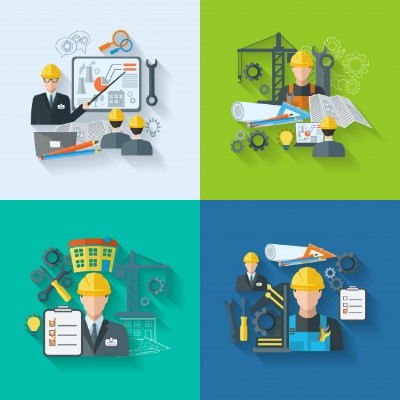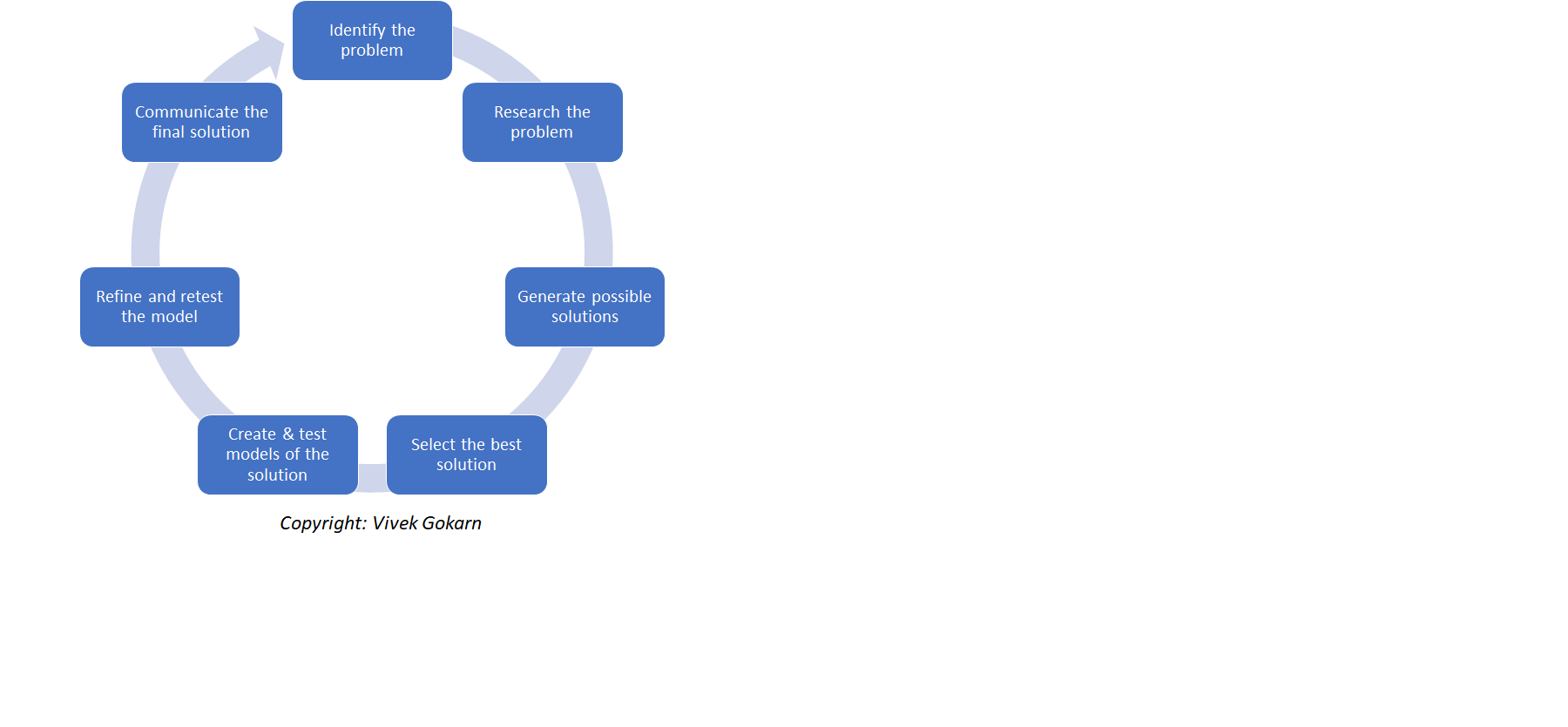Technological Design Process
Grade 6 Science Worksheets
Developing a new technology is an application of science – it is the use of scientific knowledge for a specific purpose, the purpose being to develop a particular technology. Exactly how is scientific knowledge put to use in order to develop a technology? That is where a Technological Design Process comes in.
Schedule a Free session to clear worksheet doubts
No credit card required, no obligation to purchase.
Just schedule a FREE Sessions to meet a tutor and get help on any topic you want!
Who performs a Technological Design Process?
There are many roles defined for persons who undertake a technology design process. They are primarily Engineers or Technologists who possess specialized skills as Designers. Hence the process is also termed as Engineering Design.
A typical design process consists of many steps. These steps are usually done in sequence but sometimes some steps may need to be repeated, which makes it an Iterative Process. Let us explore these steps.


Steps in the Technological Design Process
1. Identify the problem
For any new technology to come into existence, there needs to be a need or a desire. For example, depleting fossil fuels may lead to a desire to design cars that run on non-conventional sources of energy. It may also be triggered by an idea or a Vision in the mind of a scientist or an engineer, even though a need or desire is not felt. For example, the design of a touchscreen phone came to the mind of Steve Jobs, leading to the creation of the iPhone. This step requires a clear Problem Statement to be written.
Personalized Online Tutoring from eTutorWorld
eTutorWorld offers affordable one-on-one live tutoring over the web for Grades K-12, Test Prep help for Standardized tests like SCAT, CogAT, MAP, SSAT, SAT, ACT, ISEE and AP. You may schedule online tutoring lessons at your personal scheduled times, all with a Money-Back Guarantee. The first one-on-one online tutoring lesson is always FREE, no purchase obligation, no credit card required.
For answers/solutions to any question or to learn concepts, take a FREE TRIAL Session.
No credit card required, no obligation to purchase.
Just schedule a FREE Sessions to meet a tutor and get help on any topic you want!
2. Research the problem
Research is the process of finding answers to many questions that can crop up in the design process. For example, to build a car on non-conventional energy, one would research which energy source is best suited for the purpose – wind or sun or biomass fuel? If solar energy is to be used, then how best can we receive the sun’s rays? How will we convert it into usable energy? Where will we store the energy? Similar questions will arise if we researched wind energy or biomass fuel.
3. Generate possible solutions
The research will often lead to more than one solution. A designer may explore many alternatives before deciding one. Sometimes, many solutions appear feasible, and a designer will experiment with all of them in the subsequent steps before deciding on the right solution. This is where the steps can become Iterative. For example, at this stage, a designer may conclude that solar and biomass energy are the best suited to take forward, while wind energy is not feasible as a solution.
4. Select the best solution
Iterations of multiple solutions will help decide the feasibility of one particular solution which is best suited to satisfy the problem. It may be based on cost, availability of the right materials, the efficiency of the solution, how long it takes to build, and many other such factors. Taking the example forward, the designer may decide on a solar-powered car as the most feasible solution.
5. Create & test models of the solution
The designer always needs to draw Sketches and create Models or Prototypes to test the feasibility of every alternate solution. Models are usually built in a quick timeframe using relatively cheap materials, and are tested to check their functioning.
6. Refine and retest the model
The modeling process is usually iterative too – multiple models may need to be created and tested before the right one appears feasible. Sometimes, all modeling outcomes may be infeasible and the designer may need to go back to the research stage to answer more questions before returning to this step.
7. Communicate the final solution
The end result of the technological design process is the final design solution decided. This is often written and sketched in complete detail in the form of Design Specifications which are handed over to other engineers and technologists to carry out the actual build and manufacture of the solution.
This concludes the Technological Design Process.

Check Point
- A Technological Design Process is where we apply ________ in order to develop a ________.
- People who perform Technological Design Process are usually ______ or ______ with specialized skills as ________.
- Identifying the problem end with writing up a ________.
- Repeating some steps in the Technological Design Process is known as ______.
- The final outcome of the Technological Design Process is a document known as _______.
Answer Key
- Scientific knowledge, Technology
- Engineers, Technologists, Designers
- Problem Statement
- Iteration
- Design Specifications
Schedule a Free session to clear worksheet doubts
No credit card required, no obligation to purchase.
Just schedule a FREE Sessions to meet a tutor and get help on any topic you want!
Learn more about Scientific Method and other important topics with 7th Grade Science Tutoring at eTutorWorld. Our expert science tutors break down the topics through interactive one-to-one sessions. We also offer the advantage of customized lesson plans, flexible schedules and convenience of learning from home.
Pricing for Online Tutoring
| Tutoring Package | Validity | Grade (1-12), College |
|---|---|---|
| 5 sessions | 1 Month | $124 |
| 1 session | 1 Month | $25 |
| 10 sessions | 3 months | $239 |
| 15 sessions | 3 months | $354 |
| 20 sessions | 4 months | $449 |
| 50 sessions | 6 months | $1049 |
| 100 sessions | 12 months | $2049 |
6th Grade Free Worksheets
- Inquiry process
- Nature of Science
- Scientific Inquiry
- Inquiry, Analysis and Problem Solving
- Ethical Practices
- Science and Society
- Biotic and Abiotic Factors
- Impact of Organisms
- Adaptation
- Spheres of Earth
- Natural Resources
- Environmental Issues
- Conservation of Earth
- Understanding Technology
- Abilities To Do Technological Design
- Structure of Earth
- Solar System
- Rocks and Fossils
- Earth Systems
- Plate Tectonics
- Evolution
- Magnetic Field of Earth
- Geologic Time
- Materials and Processes That Shape a Planet
- Astronomy
- Ecology
- Energy
- Kinetic and Potential Energy
- Energy Transfer
- Matter and its Structure
- States of Matter
- Physical and Chemical Changes
- Force and Motion
- Electricity and Magnetism
- Wave Interactions
- Sound
- Light
- Introduction to Life Science
- The Origin & History of Life On Earth
- Plant and Animal Cells
- Parts of a Cell
- The Cell Cycle
- How Living Organisms Get Energy
- Classification of Organisms
- How Plants Grow & Reproduce
- The Human Respiratory System
- The Human Cardiovascular System
- The Human Digestive System
- The Human Endocrine Systems
- The Human Nervous System
- The Human Muscular System
- The Human Skeletal System
Images Credit:
https://image.freepik.com/free-vector/engineer-icon-flat-set_1284-3985.jpg


